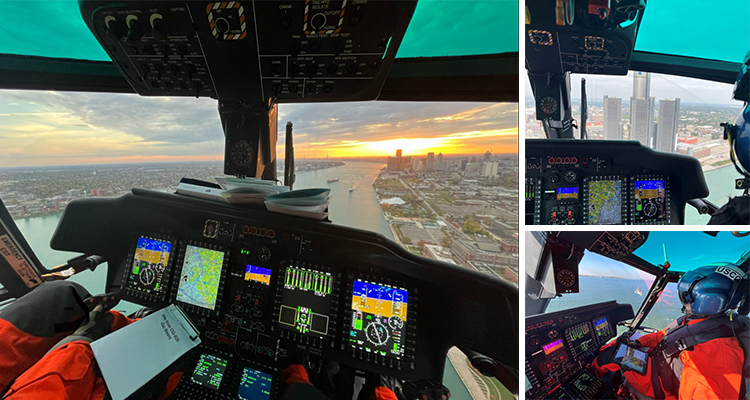Jan. 25, 2024 —

New glass cockpit displays project navigation, flight and engine performance on large screens, greatly improving situational awareness for MH-65E pilots. The screens replace the rows of dials and gauges that traditionally functioned as aircraft instruments.
Air Station Detroit rang in the new year with the transition to the upgraded MH-65E or “Echo” model short range recover helicopter.
The avionics upgrade to the MH-65E configuration provides enhanced search and rescue capabilities including modern “glass cockpit” technology that increases pilot and aircrew situational awareness and provides commonality with the service’s MH-60T Jayhawk fleet.
The upgrades also include reliability and capability improvements for the automatic flight control system, enhanced digital weather and surface radar, and multifunctional displays with more accurate fuel calculations.
The new weather radar has a multicolor display enabling pilots to see through snowstorms and better map out safe routes for winter flying. The functionality of the upgrade also allows pilots to save time by loading predesignated flight plans, allowing them to successfully navigate through treacherous weather.
“The updated flight control system adds an extra layer of confidence while flying on search and rescue cases late at night and over the water,” said Lt. Rachael McGhee, one of the unit’s pilots. “This allows more of our attention to be spent searching.”
The upgrades bring the fleet into compliance with the Federal Aviation Administration’s Next Generation Airspace Transportation System requirements and extend the aircraft service life to the late 2030s.
During the upgrade period, the unit’s 23 pilots completed a three-week transition course at the Aviation Training Center in Mobile, Alabama. Sixty-three aircrew and mechanics have received formal training delivered by a team from the Coast Guard’s Aviation Technical Training Center in Elizabeth City, North Carolina, specific to their roles and duties.
“The upgrades and advanced training will enhance the situational awareness of our aircrews and improve our mission planning capabilities,” said Cmdr. Christian Polyak, commanding officer of Air Station Detroit. “The replacement and inspection of key aircraft components as a part of the upgrade also extend the aircraft’s service life and enable us to continue ensuring maritime safety, security and stewardship far into the future.”
Air Station Detroit helicopter crews perform search and rescue, maritime law enforcement and marine environmental protection, and provide aids to navigation and ice patrol support throughout the Great Lakes region.
So far, Air Station Detroit has used the new MH-65E aircraft on seven search and rescue cases, ranging from assisting another agency in responding to a suspected kidnapping case to searching for persons in the water. Air Station Detroit has also teamed with U.S. Customs and Border Protection, along with Coast Guard Investigative Service, to pinpoint areas of repeated aircraft lazing incidents, where reckless individuals aim a laser pointer at an aircraft. These actions are dangerous to aircrews and may be subject to civil penalties or criminal prosecutions under federal law.
Air Station Detroit will be taking the MH-65E on the road this winter to Myrtle Beach, South Carolina, to garner hoisting proficiency. Over about a month, 80% of the unit will travel to Myrtle Beach to conduct training operations including practice hoisting in conjunction with Coast Guard boat stations.
Air Station Detroit helicopters and aircrews also support the North American Aerospace Defense Command’s airspace security rotary wing air intercept mission in Washington, D.C., and throughout the country as required for national security.
For more information: MH-65 Short Range Recovery Helicopter Program page